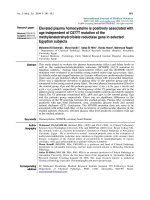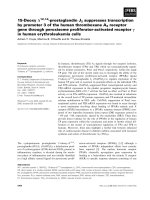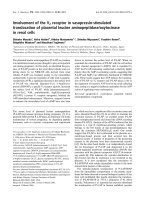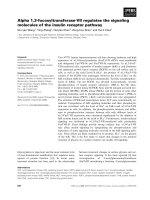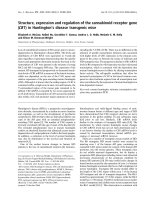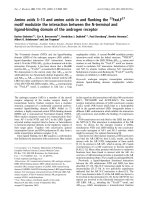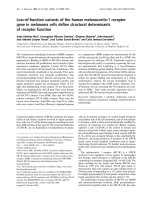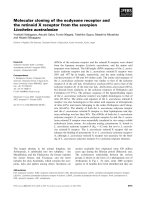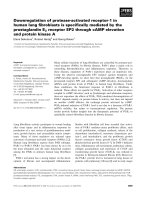Trinucleotide (CAG) repeat polymorphism of the androgen receptor gene in human disease
Bạn đang xem bản rút gọn của tài liệu. Xem và tải ngay bản đầy đủ của tài liệu tại đây (2.51 MB, 256 trang )
TRINUCLEOTIDE (CAG) REPEAT POLYMORPHISMS OF
THE ANDROGEN RECEPTOR GENE IN HUMAN DISEASE
AMPARO MIFSUD GINER
NATIONAL UNIVERSITY OF SINGAPORE
2004
TRINUCLEOTIDE (CAG) REPEAT POLYMORPHISMS OF
THE ANDROGEN RECEPTOR GENE IN HUMAN DISEASE
AMPARO MIFSUD GINER
(B. Science (Hons).Valencia)
A THESIS SUBMITTED FOR THE DEGREE OF
DOCTOR OF PHILOSOPHY
DEPARTMENT OF OBSTETRICS AND GYNAECOLOGY
NATIONAL UNIVERSITY OF SINGAPORE
2004
This thesis is dedicated to Santhosh,
Roger, Jolanda and my parents.
This thesis is mine as well as yours
ACKNOWLEDGEMENTS
Firstly and mostly I will like to thank my supervisor A/P E.L. Yong for giving me the
opportunity to work in his laboratory, for his guidance, and for the chance to work in
these interesting projects.
I would also like to acknowledge the help of:
A/P Koay and her staff team for allowing me to use the facilities in her laboratory.
Dr. Ghadessy for his help in the laboratory, interesting discussions, computing advice,
and his unconditional friendship throughout the period he was a postdoctoral fellow in
the laboratory.
To Dr. Loy for reviewing the thesis manuscript
I am also thankful to Dr. F. Dong of the department of Biostatistics for his help in
statistical analysis.
My thanks to the Doctors of the Obstetrics and Gynaecology Department mainly for
help in for collecting the blood specimens of the patients and for allowing me the
access to the medical records of the patients included in the studies.
I am grateful to our collaborators at Baylor College of Medicine for their help in the
US arm of our male infertility study.
I would like as well to say a word of appreciation to NUS for giving me the research
scholarship to complete my Ph.D
TABLE OF CONTENTS
LIST OF FIGURES
X
LIST OF TABLES
XIII
LIST OF ABREVIATIONS
XV
LIST OF PUBLICATIONS
XVIII
SUMMARY
XX
MAIN INTRODUCTION
1
1. The nuclear receptors 1
2. The androgen receptor 4
3. The polymorphic region of CAG repeats in the androgen receptor gene
9
CHAPTER 1: CAG REPEAT POLYMORPHISM IN THE
ANDROGEN RECEPTOR GENE AND MALE INFERTILITY
17
INTRODUCTION 17
1. Role of testosterone in spermatogenesis 17
2. Genetic causes of male infertility 18
MATERIALS AND METHODS 23
1. Subjects included in the study 23
2. DNA extraction 23
3. DNA amplification 24
4. GeneScan analysis 25
5. Statistical analysis 25
RESULTS 28
1. Analyses of patient population from Baylor College of Medicine, Houston 28
1.1 Characteristics of subjects 28
1.2 Determination of the CAG repeat length 28
1.3 Statistical analysis 39
1.4 Clinical characteristics of patients with > 26 CAG repeats 52
2. Analyses of patient population from The National University of Singapore 52
V
2.1 Characteristics of subjects 52
2.2 Statistical analyses 55
2.3 Clinical characteristics of patients with ≥ 26 CAG repeats 64
DISCUSSION
66
CHAPTER 2. CAG REPEAT POLYMORPHISM IN THE
ANDROGEN RECEPTOR GENE AND POLYCYSTIC OVARIAN
SYNDROME
77
INTRODUCTION 77
1. Oogenesis 77
2. Hormones involved in folliculogenesis 77
3. Definition of PCOS and selection criteria of patients 78
4. The polycystic ovary and the mechanism of anovulation. 80
5. Several markers of the condition that can be considered as diagnostic
criteria
81
6. Genetic component in polycystic ovarian syndrome. Candidate genes
studied
84
6.1 Genes coding for steroidogenic enzymes 85
6.2 Genes involved in the secretion and action of insulin 86
6.3 The follistatin gene 87
SUBJECTS AND METHODS 89
1. Study population 89
2. DNA extraction, DNA amplification and GeneScan analysis 89
3. Hormonal analysis 90
4. Data analyses 90
RESULTS 92
1. Subjects characteristics 92
2. Determination of CAG repeat length 92
3. Range of the number of CAG repeats and percentage of homozygous and
heterozygous subjects
92
4. T-test to compare the means between patients and controls 96
5. Frequency distribution of the CAG repeat sizes of the short allele and long 99
VI
allele.
6. Testosterone levels divide patients with PCOS into two subsets of AR-
CAG length
99
7. Sensitivity test to evaluate the T cut-off point. 102
8. Correlation between the number of CAG repeats and the levels of
testosterone.
108
9. CAG repeat number and the levels of LH and FSH 108
10. Ethnic differences in CAG length 108
DISCUSSION
112
CHAPTER 3: RELATIONSHIP BETWEEN PROSTATE-SPECIFIC
ANTIGEN, SEX HORMONE BINDING GLOBULIN AND
ANDROGEN RECEPTOR CAG REPEAT POLYMORPHISMS IN
SUBFERTILE AND FERTILE MEN
119
INTRODUCTION 119
1. Androgenic parameters important for prostate cancer 120
1.1 Prostate specific antigen 120
1.2. Sex hormone-binding globulin 121
1.3. Testosterone and dihydrotestosterone 122
2. Relationship among the various androgenic parameters analyzed in this
chapter
122
2.1 Association between the levels of testosterone and prostate specific
antigen
122
2.2 Association between the levels of testosterone and sex hormone-
b
inding
globulin
125
2.3 The number of CAG repeats in the androgen receptor gene and prostate
cancer
125
MATERIALS AND METHODS 127
1. Study population 127
2. Hormonal analysis and determination of the number of CAG repeats 127
3. Statistical analysis 130
RESULTS 131
VII
1. Differences between fertile and subfertile men 131
2. Bivariate correlations 135
2.1 Sex hormone-binding globulin is highly correlated with testosterone 135
2.2 Levels of testosterone and prostate specific antigen 140
2.3 Number of CAG repeats and prostate specific antigen 140
2.4 Number of CAG repeats, testosterone, and sex hormone-binding
globulin
140
DISCUSSION
147
CHAPTER 4: IN VITRO STUDIES OF THE TRANSACTIVATION
ABILITY OF THE ANDROGEN RECEPTOR GENE CONTAINING
DIFFERENT CAG REPEATS
155
INTRODUCTION 155
1.Aldehyde dehydrogenase gene 1 156
2. Prostate specific antigen gene 157
MATERIALS AND METHODS 159
1. Amplification of the prostate specific antigen promoter regions of 1.6Kb,
630bp, and 100bp
159
2. Amplification of the aldehyde dehydrogenase 1gene promoter region 160
3. Ligation reactions 161
4. Transformation 161
5. Purification of plasmid DNA 162
6. Sequencing the PSA-LUC construct 162
7. Transient transfection experiments 163
8. Harvesting the cells 164
9. Measurement of luciferase activity 164
10. Construction of the new PSA reporter system 165
11. Mammalian cell two-hybrid system experiments 165
RESULTS 166
1. Construction of the ALDH 1 reporter system 166
2. Construction of the PSA reporter systems containing the -1.6kb, -630bp
and -100bp promoter regions
169
VIII
3. Transient co-transfection experiments 177
3.1 Transient co-transfection experiments to evaluate the responsiveness of
the pM-ALDH-LUC reporter system to androgen action
177
3.2 Transient co-transfection experiments using the pM-PSA-LUC reporter
systems
180
3.3 Inducibility of the PSA 1.6Kb fragment of the PSA promoter by the
androgens DHT and MB
180
3.4 The activity of the 1.6 Kb prostate specific antigen promoter was
evaluated in other cell lines
180
3.5 pGL3-PSA- LUC reporter system 187
3.6 Cotransfection studies with the reporter system PGL3-PSA-LUC 188
3.7 Optimisation of the relative amounts of AR and PGL3-PSA-LUC 188
3.8 Differences in the CAG length in the AR may transactivate the PGL3-
PSA-LUC reporter system differently
188
4. TAD and LBD interaction using the mammalian cell two-hybrid system 189
DISCUSSION 193
CONCLUSIONS
199
REFERENCES
212
IX
LIST OF FIGURES
MAIN INTRODUCTION
PAGE
Fig. 1 Schematic representation of the Androgen Receptor gene
and protein.
6
Fig. 2 Schematic structure of the AR cDNA
11
CHAPTER 1: CAG REPEAT POLYMORPHISM IN THE
ANDROGEN RECEPTOR GENE AND MALE INFERTILITY
Fig. 1 Agarose gel electrophoresis with the PCR products
comprising the polymorphic CAG repeats region in the
AR gene.
32
Fig. 2 Gel image of the GeneScan polyacryamide gel.
34
Fig. 3 Confirmation of the fragment size that flanks the CAG
region by sequence analysis. Sample 1
36
Fig. 4 Confirmation of the size of the fragment that flanks the
CAG region by sequence analysis. Sample 2
38
Fig. 5 Q-Q plots to evaluate if the sample was normally
distributed (Baylor)
41
Fig. 6 Allelic distribution of the AR(CAG)n in the fertile and
infertile group of subjects
44
Fig. 7 Alellic distribution of the AR(CAG)n in the normal fertile
and the oligospermic group of patients
45
Fig. 8 Alellic distribution of the AR(CAG)n in the normal
fertile and azoospermic group
46
Fig. 9 Q-Q plots to evaluate if the sample was normally
distributed
57
Fig. 10 Allelic distribution of the AR(CAG)n in the control fertile
group and the infertile group
59
Fig. 11 Alellic distribution of the AR(CAG)n in the control
fertile and the oligospermic group of patients
60
Fig. 12 Alellic distribution of the AR(CAG)n in the control
fertile group and the azoospermic group of patients
61
X
CHAPTER 2. CAG REPEAT POLYMOEPHISM IN THE
ANDROGEN RECEPTOR GENE AND POLYCYSTIC OVARIAN
SYNDROME
Fig. 1 GeneScan analysis of the androgen receptor CAG length
in women
94
Fig. 2 Frequency distribution of the short AR-CAG allele of
PCOS patients and controls
100
Fig. 3 Frequency distribution of the long AR-CAG allele of
PCOS patients and controls
101
Fig. 4 Frequency distribution of the short AR-CAG allele of
PCOS patients with serum T levels below or above the
normal laboratory mean value of 1.73nmol/L.
105
CHAPTER 3: RELATIONSHIP BETWEEN PROSTATE-
SPECIFIC ANTIGEN, SEX HORMONE BINDING GLOBULIN
AND ANDROGEN RECEPTOR CAG REPEAT
POLYMORPHISM IN SUBFERTILE AND FERTILE MEN
Fig. 1 Frequency distribution of testosterone levels in fertile and
subfertile subjects.
134
Fig. 2 Scatter graphs showing the positive correlation between
the levels of SHBG and total T in the fertile group: A),
and infertile group: B).
139
Fig. 3 Scatter graphs showing the correlation between the levels
of total PSA and total T.
142
Fig. 4 Scatter graphs showing the correlation between the
number of CAG repeats in the AR gene and the levels of
total PSA.
144
Fig. 5 Scatter graphs showing the correlation between the
number of CAG repeats in the AR gene and the levels of
total T.
146
Fig. 6 Factors in the androgen economy in fertile and subfertile
subjects
154
CHAPTER 4: IN VITRO STUDIES OF THE
TRANSACTIVATION ABILITY OF THE ANDROGEN
RECEPTOR GENE CONTAINING DIFFERENT CAG REPEATS
Fig. 1 Construction of the ALDH reporter system 168
XI
Fig. 2 Cloning the 1.6Kb region of the PSA promoter gene into
the pMAMneo-LUC reporter plasmid
171
Fig. 3 Screening for positive colonies after transformation
173
Fig. 4 Sequence analysis of the promoter region of the PSA
gene
176
Fig. 5 Androgen regulation of the ALDH promoter in CV-1 and
COS-7 cells
179
Fig. 6 Androgen regulation of the PSA promoter in CV-1 cells
182
Fig. 7 Dose response activities of the PSA and MMTV promoter
in CV-1 cells.
184
Fig. 8 Co-transfection experiments with PSA reporter system in
different cell type lines
186
Fig. 9 Interaction between the NTD and LBD in the mammalian
two-hybrid system
192
XII
LIST OF TABLES
CHAPTER 1: CAG REPEAT POLYMORPHISM IN THE
ANDROGEN RECEPTOR GENE AND MALE INFERTILITY
Table 1 Clinical characteristics of the infertile group of patients
(Baylor)
29
Table 2 Results of the Dunnett’s test
43
Table 3 Protective effect of short CAG repeats on the risk of male
infertility (Baylor)
50
Table 4 Clinical characteristics of patients with > 26 CAG repeats
in the AR gene (Baylor)
53
Table 5 Clinical characteristics of the infertile group of patients
(Singapore)
54
Table 6 Results of the Dunnett’s test (Singapore)
58
Table 7 Different cut off points considered in the categorical
analysis (Singapore)
63
Table 8 Clinical characteristics of infertile patients with > 26
CAG repeats in the AR gene (Singapore)
65
Table 9 Studies to determine if the CAG polymorphic tract
predisposes to male infertility
74
CHAPTER 2. CAG REPEAT POLYMOEPHISM IN THE
ANDROGEN RECEPTOR GENE AND POLYCYSTIC OVARIAN
SYNDROME
Table 1 Clinical and hormonal characteristics of PCOS patients
95
Table 2 CAG repeats mean values for the short, long and biallelic
mean for patients and controls
98
Table 3 CAG repeats mean values were calculated and compared
for patients with ‘low T” and ‘high T” respectively
104
Table 4 Sensitivity assay
107
Table 5 Comparisons of the CAG repeats number when patients
were classified according to the hormonal levels of LH
and FSH below and above the laboratory mean value
110
XIII
CHAPTER 3: RELATIONSHIP BETWEEN PROSTATE-
SPECIFIC ANTIGEN, SEX HORMONE BINDING GLOBULIN
AND ANDROGEN RECEPTOR CAG REPEAT
POLYMORPHISM IN SUBFERTILE AND FERTILE MEN
Table1 Descriptive statistics of the various parameters measured
in the study
133
Table 2 Results of the bivariate correlations established in the
fertile group
136
Table 3 Results of the bivariate correlations established in the
subfertile group
137
CONCLUSIONS
Table 1 Role of the AR-CAG length in diseases and processes
regulated by androgens
209
XIV
LIST OF ABBREVIATIONS
aa Aminoacid
ACT Alpha-1-antichymotrypsin
ACTH Adrenocorticotropic hormone
ALDH Aldehyde dehydrogenase
AF-1 Activation function 1
AF-2 Activation function 2
AR Androgen receptor
ARA 70 AR-associated protein 70
AR-CAG CAG repeat tract in the androgen receptor gene
ARE Androgen-response element
AZF Azoospermia factor
BHP Benign prostatic hyperplasia of the prostate gland
BMI Body-mass index
bp Base pairs
CAIS Complete androgen insensitivity
CBAVD Congenital bilateral absence of the vas deferens
(CBAVD)
cAMP Cyclic adenosine monophosphate
cDNA Complementary DNA
CFTR Cystic fibrosis transmembrane conductance regulator
CHO Chinese hamster ovary
CV Coefficient of variation
CV-1 African green monkey kidney cells
CYP11a Cholesterol side chain cleavage gene
CYP17 17-hydroxylase/17,20-lyase gene
DAZ Deleted in azoospermia
DBD DNA binding domain
DHT Dihydrostestosterone
DM1 Myotonic dystrophy type 1
DMEM Dubelcco's modified eagle media
DFFRY Drosophila fat-facets related Y
DNA Deoxyribonucleic acid
XV
dNTP Deoxynucleotide triphosphates
DRPLA Dentatorubral-pallidoluysian atrophy
EDTA Ethylenediamine tetra-acetic acid
fPSA Free PSA
tPSA Total PSA
FAI Free androgen index
FBS Fetal bovine serum
FSH Follicle-stimulating hormone
GR Glucocorticoid receptor
GTF General transcription factors
Gln Glutamine
GnRH Gonadotropin-releasing hormone
HAT Histone acetyltransferase
HD Huntington disease
HRE Hormone response elements
INSR Insulin receptor gene
IGF-I Insulin like growth factor
IGFBP-3 IGF binding protein 3
IU International units
Kb Kilobases
KDa Kilo dalton
KLK Kallikrein gene
KS Klinefelter´s syndrome
LB Luria broth
LBD Ligand binding domain
LH Luteinizing hormone
LUC Luciferase
MB Mibolerone
MJD Machado-Joseph disease
MMTV Mouse mammary tumour virus
NIDDM Non-insulin-dependent diabetes mellitus
NR Nuclear receptor
OR Odds ratio
XVI
PAIS Partial androgen insensitivity
PCOS Polycystic ovarian syndrome
Poly-Gln Polyglutamine
PBS Phosphate buffered saline
PR Progesterone receptor
PRL Prolactin
PSA Prostate specific antigen
RAR All-trans retinoic acid
RBM RNA-binding motif
RLUs Relative light units
RIA Radioimmunoassay
RXR 9-cisretinoic acid
SBMA Spinal bulbar muscular atrophy
SCA Spinocerebellar ataxia
SDS Sodium dodecyl sulfate
SE Standart error
SHBG Sex hormone binding globulin
SRC Steroid receptor coactivator
T Testosterone
TAD Transactivation domain
TBE Tris-boric acid-EDTA
TFI Testosterone free index
TIF 2 Transcription intermediary factor 2
TR Thyroid hormone
TRIS Tris-hydroximetyl-aminomethane
VDR vitamin D3
VNTR Variable number tandem repeats
U Units
WHO World health organization
XVII
LIST OF PUBLICATIONS RESULTING FROM THE THESIS
Full length articles
1. Amparo Mifsud, Sylvia Ramirez, E.L. Yong. (2000) Androgen receptor gene CAG
trinucleotide repeats in anovulatory infertility and polycystic ovaries Journal of
Clinical Endocrinology and Metabolism 85:3484-8.
2. Amparo Mifsud, Chris K.S. Sim, Holly Boettger-Tong, Sergio Moreira, Dolores J.
Lamb, Larry I. Lipshultz, E.L. Yong. (2001) Trinucleotide (CAG) repeat
polymorphism in the androgen receptor gene: Molecular markers of male infertility
risk. Fertility and Sterility 75:275-81
3. Amparo Mifsud, Aw Tar Choon, Dong Fang, E.L. Yong (2001) Relationship
between prostate-specific antigen, testosterone, sex-hormone binding globulin and
androgen receptor CAG repeat polymorphisms in subfertile and normal men
Molecular Human Reproduction 7:1007-13
4. Casella R, Maduro MR, Mifsud A, Lipshultz LI, Yong EL, Lamb DJ (2003)
Androgen receptor gene polyglutamine length is associated with testicular histology in
infertile patients Journal of Urology 169: 224-7
Review articles
1. Yong, E.L, Ghadessy, FJ, Qi, W, Mifsud, A, Ng, SC. (1998) Androgen receptor
transactivation domain and control of spermatogenesis. Reviews in Reproduction 3:
141-144.
2. Yong, EL, Lim, J, Qi W, Mifsud, A, Ong, YC, Sim CKS. (2000) Genetics of male
infertility: role of androgen receptor mutations and Y-microdeletions. Annals of the
Academy of Medicine of Singapore 29: 396-400.
3. Yong, E.L., Lim, J., Qi, W., Mifsud, A. (2000) Molecular basis of androgen receptor
diseases. Annals of the Academy of Medicine of Singapore, 32:15-22.
XVIII
4. Yong, E.L., Lim, J., Qi, W., Mifsud, A., Lim J, Ong, Y.C., Sim (2000) Androgen
receptor polymorphisms and mutations in male infertility. Journal of Endocrinological
Investigation 23:573-577
Abstracts
1. Yong, EL, Wang Q, Liu PP, Mifsud A, Ghadessy FJ. The CAG repeat in the
androgen receptor gene and its relationship to sperm production and prostate
cancer.11
th
Asia-Oceania Congress of Endocrinology. February 1998, Seoul.
2. Amparo Mifsud, Farid J. Ghadessy, EL.Yong. Analysis of different promoters used
in the study of androgen receptor structure-function relationships. European Congress
of Endocrinology. May 1998, Seville.
3. A. Mifsud, S Ramirez, E.L. Yong. Non-hyperandrogenic polycystic ovarian
syndrome is associated with short CAG repeats in the androgen receptor. 49
th
Annual
Meeting of the American Society of Human Genetics. October 1999, San Francisco.
4. Dirk M. Hentschel, Amparo Mifsud, Eu Leong Yong, Joseph V. Bonventre, Steven
I-H Hsu. C/EBPα and C/EBPβ compete with the androgen receptor for binding and
transcriptional activation of the Human Prostate Specific Antigen (PSA) promoter.
ASN 32 Annual Meeting. 1999, Singapore.
XIX
SUMMARY
The androgen receptor (AR) is a member of the superfamily of steroid hormone
receptors. The AR binds to its ligands testosterone and 5α-dihydrotestosterone and
mediates essential biological processes such as male sexual differentiation,
spermatogenesis, development and maintenance of the prostate gland. The AR gene
contains a polymorphic region comprising variable number of CAG trinucleotide
repeats which encodes glutamine residues in its first exon. The average number of such
repeats is 22.5+ 2 with a range of 11 to 30 in the population of Singapore. Expansions
exceeding the value of 40 repeats cause a fatal neuromuscular disease named Spinal
bulbar muscular atrophy (SBMA) or Kennedy's disease.
Recently, besides the pathological expansions of polyglutamine lengths found in
SBMA, variations in this CAG microsatellite tract, while remaining within the normal
polymorphic range, have been inversely correlated with receptor activity. Thus short
tracts are associated with high intrinsic AR activity whereas longer CAG tracts are
associated with low AR activity.
In this thesis, the role of the polymorphic CAG repeats stretch in the activity of the AR
was investigated in three diseases/conditions: male infertility, Polycystic Ovarian
Syndrome (PCOS) in women, and prostate cancer. Subsequently, the mechanism by
which the different CAG length confers different transactivation activity to the AR was
investigated in cell culture studies by using human promoters.
XX
To elucidate the relationships between CAG repeats and male infertility, we examined
the distribution of AR-CAG alleles in infertile population from an American center,
compared it to a different ethnic group from Singapore, and explored clinical
phenotypes associated with long AR-CAG alleles. The mean AR-CAG length of
infertile American patients was significantly longer than fertile controls. Logistic
regression showed that each unit increase in CAG length was associated with a 20%
increase in the odds of being azoospermic. The odds ratio for azoospermia was 7-fold
higher for patients with >26 CAG repeats than those with <26 CAGs. Although mean
CAG length in Singapore subjects was longer than the corresponding American
samples, long AR-CAG alleles were significantly related to male infertility in both
populations.
To investigate the role of the CAG repeat tract in PCOS, we measured its length in 91
patients and compared them to 112 fertile subjects. There were no differences in the
mean CAG length between patients and controls when both alleles were considered
together or separately. Since there is a subset of PCOS patients whose serum
androgens are normal, we compared differences in CAG length between patients
whose serum T levels were below the normal laboratory mean, to those that were
higher. There was a difference in CAG length between patients with low and high T
levels (20.38±0.51 vs 21.98±0.29), (p=0.004) when only the shorter allele of each
individual was considered. Ethnic differences were also evident in our data, Indian
subjects had a significantly shorter AR-CAG length compared to Chinese, being
22.08±0.50 and 23.16±0.17 respectively.
XXI
To understand the factors in the androgen economy that regulate Prostate Specific
Antigen (PSA) levels (the most commonly used marker for prostate cancer), we
measured levels of total and free T, Sex hormone binding globulin (SHBG), and the
AR CAG repeat length. We then compared these to the total and free PSA levels in 91
fertile subjects, and 112 subfertile men with defective spermatogenesis. Our data
suggested that, firstly, PSA correlated with T only in an environment of relatively low
androgenicity, such as in subfertile patients. Secondly, in a low androgenic
environment, short CAG tracts were associated with high PSA levels.
Lastly, to understand the molecular mechanism by which the size of the AR
polyglutamine tract may modulate the activity of the AR, reporter systems containing
androgen responsive human promoter were constructed and the activity of the AR
tested in cell culture experiments.
In summary, the results from the three different studies in humans indicated that short
CAG tracts were associated with high levels of androgen action leading to PCOS in
females and high levels of PSA in males. Conversely, long CAG tracts were
associated with low androgen receptor activity leading to male infertility.
XXII
MAIN INTRODUCTION
1. The nuclear receptors (NRs)
1.1 Description
The NRs are ligand-inducible transcription factors that specifically regulate the
expression of many essential target genes involved in metabolism, development and
reproduction. Their main function is to mediate the transcriptional response in target
cells in response to ligands such as the sex steroids (progestins, estrogens and
androgens), adrenal steroids (glucocorticoids and mineralocorticoids), vitamin D3, and
thyroid and retinoid hormones. This superfamily encompasses the single largest class
of eukaryotic transcription factors.
1.2 Classification
Phylogenetic analyses have identified three main subfamilies within this superfamily.
Type I or steroid family includes the receptors for progestins, estrogens, androgens,
glucocorticoids, and mineralocorticoids. In the absence of ligand they are bound to
heat shock proteins and in this form they are inactive. In the presence of ligand they
bind to palindromic repeats located in the promoter of targeted genes in a homodimeric
head- to head arrangement. Type II receptors encompass those for thyroid hormone
(TR), all-trans retinoic acid (RAR), 9-cisretinoic acid (RXR), and vitamin D3 (VDR).
They are able to bind to their promoter DNA in the absence of ligand, and often exert a
constitutive repressive effect upon the expression of the target genes. Ligand biding
then relieves the repressive effect. The difference with the type I receptors is that they
often form promiscuous dimers, mainly involving the presence of the RXR. Type III
receptors contain the orphan receptors.
1
1.3 NRs structure
In the majority of the NRs, the receptor structure is comprised of six domains, named
from A to F. Domains A/B are highly variable in sequence and length and they
comprise the amino terminal activation function 1 (AF-1) that activates target genes
presumably by interacting with components of the core transcriptional machinery,
coactivators, or other transactivators. The domain C named DNA-binding domain
(DBD) contains two zinc fingers, which are responsible for DNA recognition and
dimerization. The domain D allows the protein to bend or change conformation and
often contains a nuclear localization signal sequence. Domain E or carboxy-terminal
ligand binding domain (LBD) includes the activation function 2 (AF-2). This domain
has been studied in great detail due to the availability of crystal structures with
different ligands and coactivators. In addition to its ligand-binding properties this
region is important for dimerization, nuclear localization, transactivation and
intermolecular silencing. The domain F is present only in certain receptors and its
function remains unknown.
1.4 Mode of action of the NRs
Steroid and thyroid/retinoid hormones regulate transcription via enhancer elements
that may be several kilobases from their target promoters, at which transcription is
mediated by RNA polymerase II (Mc Kenna et al., 1999). The nuclear receptors and
some of its specific coactivators interact directly or indirectly with the components of
the basal transcription machinery. Direct protein-protein interaction between NR and
GTFs (general transcription factors) had been reported in a number of studies. For
instance Schulman et al. (1995) described the association between a portion of the
TBP (TATA–binding protein) and the AF-2 region of the RXR. This interaction is a
direct, specific and ligand-dependant.
2
Eukaryotic DNA is structured into nucleosomes, and this complex structure has to be
dismantled in order to make the DNA accessible to the transcription machinery. One of
the mechanisms to achieve the physical separation of the DNA from the histone
proteins is through the acetylation of some core histone residues. The acquisition of
negative charges as a result of acetylation makes the separation between histones and
the negatively charged DNA possible, thereby creating an environment where the
DNA is more accessible to transcription factors. In 1995 Brooks et al., identified the
first histone acetyltransferase (HAT)-A, a Tetrahymena protein that contain
acetyltransferase activity. Their discovery was the first indication that the recruitment
of histone acetylation activity by sequence-specific transcription factors might be
involved in transcriptional regulation in eukaryotes. After this first discovery, various
proteins with acetylation activity have been identified including some nuclear
coactivators.
Numerous coactivators have been characterized in recent years and they have been
classified into two major types. The Type I coactivators function primarily with the
nuclear receptor at the target gene promoter to facilitate DNA occupancy, chromatin
remodelling, or recruitment of general factors associated with the RNA polymerase II
holocomplex. Examples of type I coactivators are those belonging to the steroid
receptor coactivator (SCR) family such as the human SRC-1 (Li et al., 1997). The
Type II coactivators modulate the appropriate folding of the AR and its ligand, and
facilitate the AR NH
2
/COOH-terminal interaction. This category includes coactivators
that stabilize the ligand-bound receptor, such as AR-associated protein 70 (ARA70)
(Yeh et al., 1996).
3
